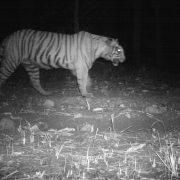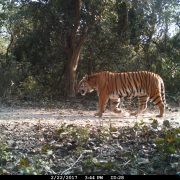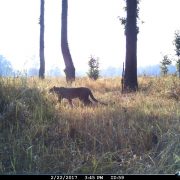Encounters between local people and large carnivores such as tigers, leopards, and sloth bears are reported to be increasing in the Terai lowlands bordering India and Nepal, eroding the existing tolerance towards wildlife and undermining efforts for biodiversity conservation.
To address this challenge, the project, supported by DEFRA’s Darwin Initiative grant over multiple years, aims to establish a sustainable conflict management model. This initiative will empower local communities residing in project villages while fostering biodiversity conservation beyond the Protected Areas (PAs).
CHALLENGES:
Chitwan National Park in Nepal and Valmiki Tiger Reserve in India have witnessed a gradual rise in the number of tigers and other co-predators owing to decades of successful conservation work. This is resulting in elevated levels of negative interactions between local people and the large carnivores such as tigers (Panthera tigris tigris), Asiatic leopards (Panthera pardus fusca) and sloth bears (Melursus ursinus).
While coexistence thrives in these landscapes, increasing negative interactions have started to alter tolerance and perception among communities. This is significant for broader conservation efforts around these key species, as support from local communities is key in maintaining positive momentum and avoiding escalation of retaliatory action. The project has begun efforts to develop a sustainable community-led conflict management model in these two national parks to reduce and prevent human-carnivore conflict.
PROJECT AIMS:
The project aims to mitigate losses arising from negative interactions with large carnivores through multifaceted approaches. One such approach is to provide training to community members to protect their livestock and advocate stall feeding practices, thereby reducing the need for individuals to venture into forests for fuelwood and other resources. Crucially, we will establish local volunteer-based Primary Response Teams (PRTs) to proactively address and prevent escalation of conflict situations.
In addition, the project seeks to combat poverty in these regions by fostering non-forest dependent ‘green’ livelihoods and enhancing energy security through the adoption of sustainable fuel alternatives, thereby lessening reliance on forest-derived resources. Moreover, it aims to gain an understanding of the mental health and well-being ramifications of such negative interactions and resultant conflicts.
Finally, this project aims to address the pervasive issue of biased public narratives surrounding human-large carnivore interactions, often sensationalised by the media, and inadequately addressed by the local forest departments. Towards this, targeted workshops will be conducted annually for forest department personnel and local media representatives, employing a participatory approach that blends theoretical knowledge with practical insights to foster effective conflict mitigation strategies, and an unbiased dissemination of wildlife news by media outlets.
PROJECT APPROACH:
The project is being implemented by in-country partners: The National Trust for Nature Conservation, and the Wildlife Trust of India, who have long-standing experience and knowledge of conservation issues and solutions, as well as on socio-political situation of the project areas.
The project has been developed through close consultation with our partners’ field teams. Further to this, all initiatives are planned out in detail with the targeted communities onboard in order to garner adequate buy-in before implementation. The project also adopts a ‘train-the-trainer’ approach in implementation of majority of its initiatives, by developing local skills and stewardship, thereby working towards sustainability of the project.
OUR TEAM OF EXPERTS WORK IN SIX REGIONS AROUND THE GLOBE – REPRESENTING SOME OF THE PLANET’S MOST BIODIVERSE HABITATS. Discover more about our SCIENCE AND CONSERVATION work.



